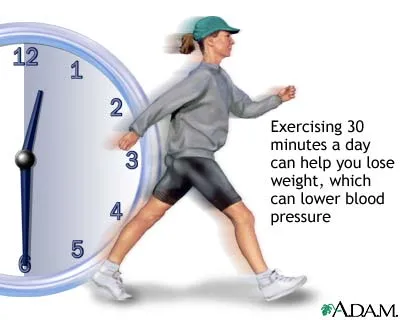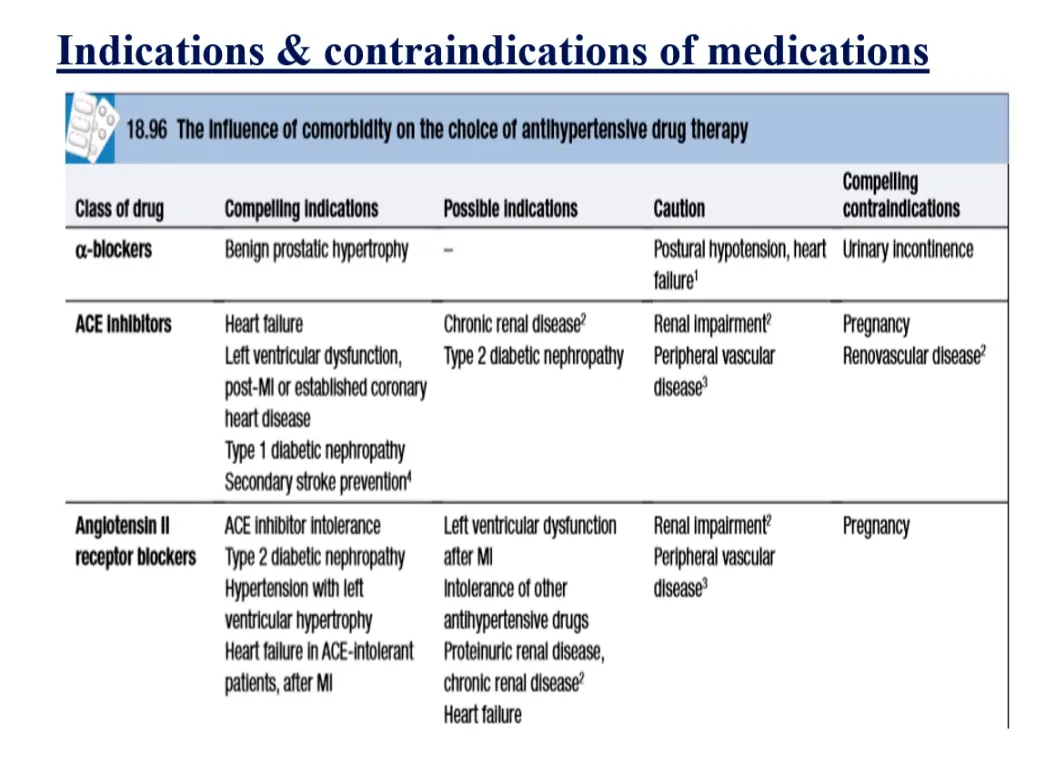Management of Hypertension
- Investigate appropriately a patient with hypertension.
- Advice initial management plan for a patient with hypertension according to recent guidelines (SHAMS - 2018).
- Discuss non-drug management of hypertension.
- Identify long term complications of hypertension.
- Discuss the screening criteria for HTN.
HTN Treatment
- Non-Pharmacological
- Pharmacological
Blood Pressure Target
- General Population ≥ 60 years … < 150/90 mmHg
- Adults ≥ 30 years … diastolic BP < 90 mmHg
- Adults ≥ 60 years … Systolic BP < 150 mm Hg
- Patients with DM and Chronic Kidney Diseases (CKD) … < 140/90
1. Lifestyle Modifications
- Adoption of the Dietary Approaches to Stop HTN (DASH) Diet.
- Salt restriction
- Weight reduction
- Alcohol consumption abstinent
- Regular aerobic physical activity
- Smoking cessation
Dietary Approach to Stop HTN (DASH)
- Low content of cholesterol and total fat
- Focuses on fruits, vegetables, and fat-free or low-fat dairy products
- Rich in whole grains, fish, poultry, beans, seeds, and nuts
- Contains fewer sweets, added sugars and sugary beverages, and red meats
- Dietary sodium restriction ideally to 1.5 g/day

What is the DASH Diet?
- Total fat: 27% of calories
- Saturated fat: 6% of calories
- Cholesterol: 150 mg
- Carbohydrates: 55% of calories
- Fiber: 30 g
- Protein: 18% of calories
- Sodium: 1,500 mg
- Potassium: 4,700 mg
- Calcium: 1,250 mg
- Magnesium: 500 mg
Special Conditions/Groups
- Resistant hypertension
- Prevalence is estimated to be around 10%.
- Defined as seated office BP > 140/90 mm Hg in people managed with three or more antihypertensive medications at optimal (or maximally tolerated) doses including a diuretic.
- Secondary hypertension and pseudo-resistant hypertension (poor BP measurement technique, white coat effect, nonadherence, and suboptimal choices in antihypertensive therapy) should be first excluded.
National Heart Center/Saudi Heart Association 2023 Guidelines on the Management of Hypertension
Treatment Guidelines
General Treatment Recommendations
-
Both diuretics and ARB may affect treatment outcomes. The thiazide-like diuretics chlorthalidone and indapamide might be favored.
-
Spironolactone should be considered in treatment-resistant hypertension.
-
In case of treatment failure refer to a specialized care center.
Diabetes Mellitus
- Initiate therapy when BP is equal to or higher than 130/80 mmHg and target a BP level below 130/80 mmHg.
- ACEs or ARBs are recommended especially in the presence of albuminuria or renal involvement.
- CCBs and beta blockers are also safe to use.
- Combination of a CCB and an ACE was found to consistently lead to BP lowering as well as significantly lower cardiovascular mortality.
Chronic Kidney Disease
- The most effective are ACEs and ARBs.
- Combination therapy with an ACE and ARB carries a notable risk of hyperkalemia and acute kidney injury and is therefore not recommended.
- When more BP lowering is needed, ACEs or an ARB can be combined with other antihypertensive drugs, such as dihydropyridine CCBs.
Coronary Artery Disease
-
It is recommended that a SBP range 120-130 mmHg be targeted for all people with CAD, with a higher range 130-139 mmHg for older people. Maintained DBP between 70 and 80 mmHg.
-
Beta blockers and RAS blockers (ACEs or ARBs) are preferred.
-
CCBs are also beneficial.
Heart Failure
-
Target SBP < 130 but not < than 120.
-
Trials have demonstrated the efficacy of diuretics, beta-blockers and RAS blockers (ACEs or ARBs).
Acute Stroke and CVD
-
Immediate reduction of BP should only be attempted in case of acute intracerebral hemorrhage and very severe HTN (SBP 220 mmHg).
-
The SBP of people who suffered a transient ischemic attack or an ischemic stroke should be maintained at 120-130 mmHg in order to reduce the risk of future stroke.
-
As for drug choice, a RAS blocker in combination with a CCB or a thiazide-like diuretic is recommended for stroke prevention.
Atrial Fibrillation
- Prevention with oral anticoagulation is necessary.
- Beta blockers or non-dihydropyridine CCBs are recommended.
Pregnancy
- In general, antihypertensive drugs are recommended when SBP is ≥150 mmHg or DBP ≥95 mmHg.
- Treatment of choice for non-severe HTN includes methyldopa, labetalol, and CCBs.
- As for severe HTN, nifedipine, hydralazine, labetalol, and methyldopa have been shown to be effective.
- Intravenous (IV) labetalol Z or nicardipine and magnesium sulphate are recommended for hypertensive crisis in pregnant women.
Older Age (>65 Years Old)
-
If tolerated, a treatment target of < 130 is reasonable.
-
Combination therapy might not be favorable in very old people.
-
Avoid loop diuretics and alpha blockers due to risk of fall.
Hypertensive Emergencies
-
A hypertensive crisis denotes severe elevations of blood pressure (>180/120 mm Hg) associated with acute target organ damage, typically present as acute aortic dissection, acute myocardial ischemia, or acute heart failure.
-
It is recommended to admit the patient & use I/V medications.
Main Target of Treatment
The main target of treatment is to control BP. Antihypertensive medications that can be considered for initial treatment:
- Diuretics (thiazide and thiazide-like agents)
- ACEis
- ARBs
- Long-acting dihydropyridine CCBs
- Beta blockers (when indicated)
Beta blockers can be used in specific indications (young age, sympathetic overdrive, ischemic disease, heart failure, obesity/bariatric surgery).

Indications & Contraindications of Medications
Influence of Comorbidity on the Choice of Antihypertensive Drug Therapy
| Class of Drug | Compelling Indications | Possible Indications | Caution | Compelling Contraindications |
|---|---|---|---|---|
| α-blockers | Benign prostatic hypertrophy | – | Postural hypotension, heart failure¹ | Urinary incontinence |
| ACE inhibitors | Heart failure | Chronic renal disease² | Renal impairment² | Pregnancy |
| Left ventricular dysfunction, post-MI or established coronary heart disease | Type 2 diabetic nephropathy | Peripheral vascular disease³ | Renovascular disease² | |
| Type 1 diabetic nephropathy | ||||
| Secondary stroke prevention⁴ | ||||
| Angiotensin II Receptor Blockers | ACE inhibitor intolerance | Left ventricular dysfunction after MI | Renal impairment² | Pregnancy |
| Type 2 diabetic nephropathy | Intolerance of other antihypertensive drugs | Peripheral vascular disease³ | ||
| Hypertension with left ventricular hypertrophy | Proteinuric renal disease, chronic renal disease² | |||
| Heart failure in ACE-intolerant patients, after MI | Heart Failure |

Indications & contraindications of medications

 Z Compelling indications and contraindications
Z Compelling indications and contraindications
Isolated Systolic Hypertension
-
Persistent high Office SBP ≥140 mm Hg and Office DPB <90 mm Hg.
-
Effective treatment for isolated systolic HTN is CCB & Diuretics.
Antihypertensive Drug Treatment for People Aged Under 80 Years with Stage 1 Hypertension Z
- Target organ damage
- Established cardiovascular disease
- Renal disease
- Diabetes
- A 10-year cardiovascular risk equivalent to 20% or greater.
Follow-Up
- Labs: Potassium and Creatinine, may be sodium
- At initiation of treatment
- 2-4 weeks after starting
- Again after every dose adjustment
- Annually
Strategies Regarding Dosage and Medication Titration
-
A- Start one drug, titrate to maximum dose, and then add a second drug
-
B- Start one drug and then add a second drug before achieving maximum dose of the initial drug Z
-
C- Begin with 2 drugs at the same time, either as 2 separate pills or as a single pill combination